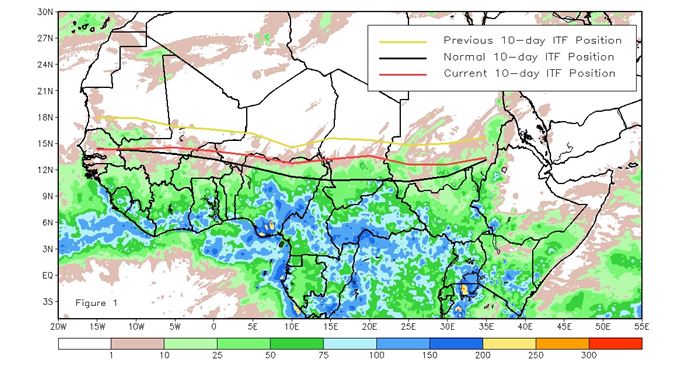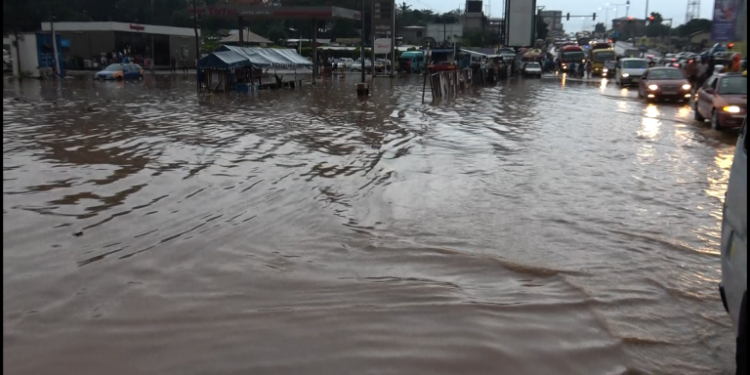October 2019 has been a very wet period in Ghana. Accra for example has recorded its wettest October since records began in 1960 leading to several cases of flooding in the city. The Accra-Tema motorway recorded its first incidence of flooding since it was constructed in 1965. Other places in the country have equally been inundated with floods.
More than 100 people are estimated to have died from floods across the country according to media reports. Could the rainfall experienced this year be the result of global climate change? Is Ghana’s rainfall pattern becoming more extreme? These and many more questions have been the points of discussion in the Ghanaian media. Based on rainfall data from Accra for the period 1960-2019, this article seeks to provide some answers to these questions and also raise some issues that city authorities and planners may need to consider to minimise the impacts of flooding on Accra in particular and Ghana as a whole.
Speak to any Ghanaian adult about weather and they are likely to talk about how rainfall patterns have changed in recent decades or years. Anecdotes about rainfall events in particular years and the impact it had on livelihoods abound in many communities. Weather wise, 1983 is perhaps the most memorable year for most Ghanaians because severe droughts led to food shortages and famine. Stories about how people coped with events of 1983 could fill an entire library and is beyond the scope of this short article. Figure 1 below shows the rainfall pattern over Accra for the period 1960 to 2019.
The top figure (A), which is the annual total rainfall shows that although rainfall amounts vary on yearly basis, there is no indication of a definite change. 1968 recorded the highest rainfall total of approximately 1400 millimeters while 1983 had the lowest rainfall about 330millimeters. The average rainfall for Accra is 800 millimeters per year.
The middle panel (B) shows the number of rain days on which there was unusually heavy rainfall of more than 50 millimetre recorded and this also tells a similar story to that of the total rainfall. 1963 recorded 12 days of heavy rainfall while 1983, 1990, 2012 and 2013 all recorded only 1 of such heavy rain events. Here too there is no observable change in the rainfall pattern. This is not to conclude that climate change is not affecting Accra’s rainfall. There is just no evidence that it has affected either the total rainfall amount or the frequency of extreme rainfall events.
However, the final panel (C), provides a different picture. This panel shows the total rainfall for the month of October which is considered to be the cessation month for rainfall over southern Ghana. What is obvious from this image is that rainfall in October has been on the increase in the last five years compared with other years. Indeed, 2019 recorded the highest October rainfall since measurements began in 1960.
This indicates that although the total amount of rainfall has not increased, the rains are going further into the year leading to longer rainy season. Again, we cannot immediately attribute the change in the length of the rainy season to climate change because other factors could be responsible. However recent research findings project that climate change is likely to lead to prolonged rainfall season over West Africa and what see for Accra may be evidence that this is already happening

Figure 1: Precipitation pattern over Accra for the period 1960 to 2019. Panel (A) shows the total annual rainfall, panel (B) shows the number of days on which unusually heavy rainfall occurred in each year and panel (C) shows the total rainfall ammount for October each year. Note that heavy rainfall is defined as any rainfall amount greater than 50 millimeters.
Is there any meteorological explanation for this year’s rainfall pattern?
Rainfall over Ghana and the rest of West Africa is controlled by the north-south or south-north movement of the sun. As the sun makes this journey, it creates a zone where moist winds from the ocean and dry winds from the Sahara desert meet. This zone is called the Intertropical Convergence Zone (ITCZ). The ITCZ follows the sun on its journeys to the northern and southern hemispheres and this is what determines which parts of Ghana receive rainfall and which parts remain dry. Areas to the south of the ITCZ are usually wet while areas to the north remain dry. As shown on Figure 2 below, the normal location of the ITCZ in October should be latitude 13 degrees north but this year it has been staying between latitudes 15 and 18 north. This position allowed moisture from the Atlantic Ocean to move inland and led to the increased rainfall that has been observed throughout the country. November is also likely to be wet if this observed pattern in the ITCZ continue.

Figure 2: ITCZ position for the 10-20th (yellow) and 20-30th (red) October compared to the normal position for October (black). The colours on the map show rainfall anomalies in millimeters. Note that most places have received between 50 and 150 millimeters more rainfall than usual. Image was sourced from https://www.cpc.ncep.noaa.gov/products/international/itf/itcz.shtml
If the rainfall pattern hasn’t changed, why are there more floods?
Since we have already established that the rainfall amounts haven’t changed over the last few years, it is very likely that human activities are the main course of the increasing flooding incidences in Accra. Accra’s population has been on the increase with a corresponding increase in the need for housing and other social amenities. One consequence of the rapid expansion in housing and other infrastructural projects is the massive reduction in in the percentage of Accra’s land-surface from that is covered with vegetation. Accra is increasingly becoming a ‘concrete jungle’ which has reduced the natural ability of the surface to absorb rain water and contributed negatively to the occurrence of flooding in the city .
Poor planning and citing of houses, offices and other physical structures coupled with poor drainage and sanitation has become rife in the city. Most of the floods experienced in Ghana are flash floods which occur in the aftermath of intense and or continuous rainfall leading to fast accumulation of run-off water that the underlying ground cannot absorb, or drain away fast enough. For example, on June 3rd, 2015 a rainfall amount of 212.8mm over Accra led to flooding over many areas and a subsequent explosion at a fuel filling station at Kwame Nkrumah circle, led to the deaths of 154 people who had taken shelter from the rains and floods there.
Poor drainage is the main cause of this type of flood and there is an urgent need to fix the drainage problem in Accra if the issue of perennial flooding is to be addressed comprehensively. This article doesn’t provide any solutions to the flooding problem but in subsequent articles, we shall provide some innovative ideas that could be adopted by city authorities to deal with floods.


Comments are closed.